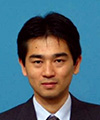 |
|||||||||||||||
|
|
|||||||||||||||
|
Feature Articles: All-Photonics Network for Enabling Innovative Optical and Wireless Network (IOWN) Vol. 18, No. 5, pp. 14–18, May 2020. https://doi.org/10.53829/ntr202005fa2 Ultra-high-capacity Optical Communication TechnologyAbstractWe are researching two new technologies for sustainably and economically responding to the exponentially increasing demand for data communications: (i) optical-fiber technology for space-division multiplexing transmission overcoming the capacity limitations of existing optical fiber and (ii) terabit-class high-speed optical-transmission technology that increases channel speed per wavelength by more than one digit. By integrating new optical-fiber and high-speed optical transmission technologies, we aim to implement a new optical-transmission infrastructure with more than 100 times the potential of current optical fiber. Keywords: high-capacity transmission, wavelength-division multiplexing, space-division multiplexing 1. IntroductionData-communication capacity is increasing at an annual rate of 10%, and it is expected to increase exponentially on the full-scale introduction of 5G (fifth-generation mobile communication) and the Internet of Things (IoT). It is a concern that in the latter half of the 2020s, the capacity limit of the currently used optical fiber, namely, single-mode fiber (SMF), will be reached. Therefore, we are promoting research to overcome the current capacity limit by using space-division multiplexing (SDM) in addition to conventional wavelength-division multiplexing (WDM) [1]. Our research on ultra-high-capacity transmission technologies, namely, optical-fiber technology for SDM transmission and high-speed optical transmission with transmission speeds up to terabits (1012 bits) per second, is introduced in this article. 2. SDM optical-fiber technologyAs shown in Fig. 1, to create SDM optical fiber that can exceed the capacity limit of existing SMF, it is feasible to increase the number of cores and modes (types of light). The type that uses core multiplexing is generally called multi-core fiber (MCF), and the type that uses mode multiplexing is generally called few-mode fiber (FMF). For few-mode multi-core optical fiber (FM-MCF), which combines N cores and M modes, it is conceivable that the transmission capacity of one optical fiber can be increased up to N × M times.
As shown in the cross-sectional photograph in Fig. 2(a), MCF with four cores within the standard cladding diameter can be manufactured with the same fineness (125-μm diameter) as existing SMF. By making MCF have the same diameter as that of existing SMF, it is possible to use current cable and connector technology. On top of that, each core of the resulting MCF is fully compatible with existing SMF; as a result, compatibility with current optical transmission systems can be improved, and practicality is assured. In fact, while making the optical performance of each core the same as that of existing SMF, in proof-of-principle experiments in collaboration with multiple vendors, we prototyped a 100-km-long 4-core fiber with common specifications, sufficiently reduced leakage between cores (crosstalk), and succeeded in optically amplifying and relaying data at a transmission capacity of more than 100 terabits per second over 300 km [2]. At NTT R&D Forum 2019, a dynamic exhibition using 4-core fiber based on the above technologies was held. An example of the future possibility of increasing the amount of spatial multiplexing by more than 100 times by using FM-MCF (in which each core of the MCF supports multi-mode propagation) as the transmission path is shown in Fig. 2(b). The horizontal axis shows the number of spatial channels (obtained by multiplying the number of cores and number of modes), and the vertical axis shows relative spatial-multiplexing density based on that of existing SMF. The circular, square, and triangular plots represent the number of modes that can be propagated by each core; 3, 6, and 10 modes, respectively. Studies using 6 modes, 42 (7 cores × 6 modes) and 114 (19 cores × 6 modes) spatial channels have been conducted (e.g., [3]). However, the relative density of the FM-MCF was only about 50 times that of existing SMF. Accordingly, by increasing the number of modes per core to 10, we achieved the world’s highest number of spatial channels; 120, via 12 cores × 10 modes and, at the same time, a relative density exceeding 100 [4]. This is the world’s first study demonstrating that the best mix of core multiplexing and mode multiplexing can achieve 100 times the potential of existing SMF in terms of both spatial-multiplexing amount and spatial-utilization efficiency. To construct the above-mentioned FM-MCF system, it is necessary to (i) increase the diameter of FM-MCF to about 1.5 times (about 200 μm) that of existing SMF and (ii) improve the manufacturability that can handle large-diameter optical fiber and to develop technologies for fabricating cables. We are also working on large-scale digital-signal-processing technology for stably multiplexing/dividing modes on the transceiver/receiver side.
3. Terabit-class high-speed optical-transmission technologyTo economically increase the capacity of optical communication, it is important to increase channel capacity per wavelength, increase the symbol rate, and apply high-order multilevel digital modulation/demodulation technology. Fundamental technologies for configuring an ultra-high-speed optical transceiver required for 1-terabit-class optical transmission are shown in Fig. 3. The ultra-high-speed optical transceiver mainly consists of an ultra-high-speed digital-signal-processing circuit, namely, a digital signal processor-application specific integrated circuit (DSP-ASIC), and an ultra-high-speed optical front-end circuit (which converts optical signals to electrical ones and vice versa). Currently, digital-signal-processing technology that can operate up to a channel capacity of 600 Gbit/s and an optical front-end circuit—consisting of a driver-integrated coherent driver modulator (CDM) and an integrated coherent receiver (ICR)—are in the practical implementation phase. Long-distance-transmission experiments applying these fundamental technologies in the field have been successful [5]. From the standpoint of datacenter interconnection and metropolitan area networks, etc., optical transceiver circuits must be downsized and their power consumption reduced. To achieve dramatic miniaturization of ultra-high-speed optical-front-end circuit technology, research and development (R&D) on a coherent optical sub-assembly (COSA), in which all optical circuits, except for the wavelength-tunable light source, are integrated on a single chip, is progressing well.
R&D on achieving high-speed channel transmission exceeding 1-Tbit/s capacity per wavelength is also underway [6]. Recently, a long-distance WDM transmission experiment using existing SMF achieved a world-first capacity of 1 Tbit/s per wavelength by using a new approach to optical front-end circuit technology, namely, an optical and electronic integrated configuration. Moreover, by integrating an analog multiplexer integrated circuit (AMUX IC) (with a bandwidth of over 100 GHz) and a broadband indium phosphide (InP) semiconductor modulator into an integrated module, the world’s fastest channel capacity of 1.3-Tbit/s transmission was achieved. These fundamental technologies can be used with the above-described MCF composed of a conventional single-mode core. For future high-capacity, flexible optical networks, fundamental technologies such as (i) SDM-wavelength selective switch (SDM-WSS) integrated technology (which enables selective switching of signal light multiplexed in the space and wavelength domains), (ii) high-efficiency wavelength-conversion technology, and (iii) in-device high-density wiring technology using MCFs are expected to be improved, and we will continue to accelerate our R&D accordingly [1, 7]. 4. Future developmentsWe will work to establish standard-cladding-diameter MCF and its related technologies. By using terabit-class high-speed optical-transmission technology, we also plan to create an ultra-high-capacity optical-transmission platform that has 100-times more potential than that of existing SMF. References
|
|||||||||||||||















